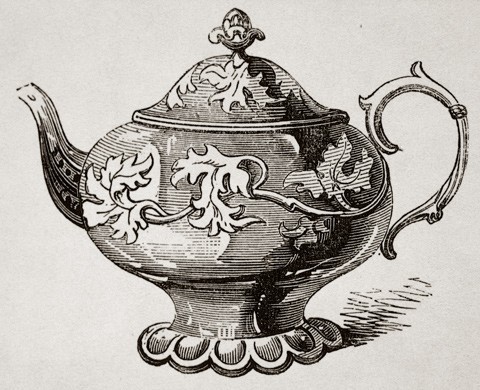
Engraving of teapot, earthenware with colored clay ornament; Messrs. Clay and Edge of Burslem, Staffordshire. This drawing appeared in the Art Journal Illustrated Catalogue: The Industry of All Nations, 1851, reprinted as Great Exhibition: London’s Crystal Palace Exposition of 1851 (New York: Gramercy Books, 1995), p. 41. The catalog entry for this teapot reads, “A patented branch of their [Clay and Edge] business is devoted to the ornamentation of similar articles by inlaying clays of various tints, thus producing an indestructible colouring for the leaves and other ornaments.” At the end of Eliza Cook’s tales, she gives a charge to ‘good Summerley and his disciples’ to ‘beautify what thou canst for the people’ and ‘give beauty to poor places’” (p. 46). Summerley was none other than Sir Henry Cole, who had introduced the Journal of Design and Manufacture in 1847 and was one of the chief organizers of the 1851 exhibition.
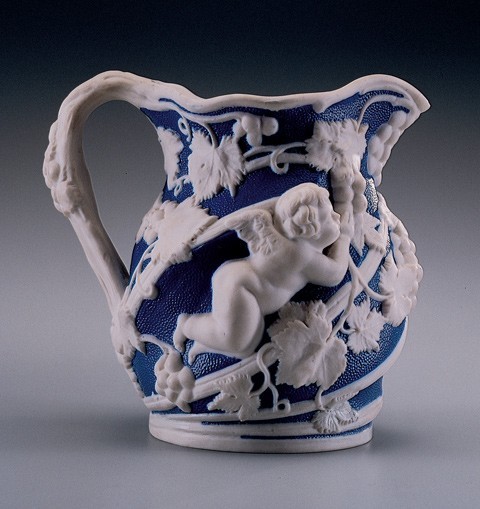
Jug, Minton and Company, Stoke-on-Trent, Staffordshire, 1840–1860. Stoneware. H. 6 1/4". (Private collection; photo, Gavin Ashworth.) The “Felix Summerley” tea-set designed by Cole (discussed above) was produced by Minton and Company. Herbert Minton made a wide array of table and tea wares in earthen, stone, and Parian wares, and he developed many lower-priced colored bodies, including the colors turquoise, blue, and “blue suck.” The jug depicted here is similar to those awarded prizes by the Royal Society of Arts in the late 1840s (Joan Jones, Minton: The First Two Hundred Years of Design and Production [Shrewsbury: Swan Hill Press, 1993]).

Tea bowl and saucer, Ching-tê-chên, China, circa 1730. Hard paste porcelain. D. of saucer: 4 3/8". (Private collection; photo, Gavin Ashworth.) Images of Adam and Eve, while common on English delftwares of the seventeenth and early eighteenth centuries, are rare on Chinese porcelain. This tea bowl and saucer were enameled in the Netherlands.
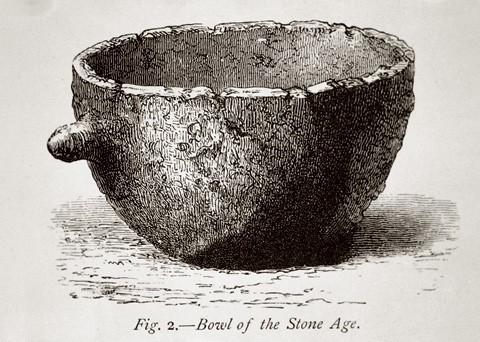
“Cooking pot of the Stone Age” illustrated in Charles Wyllis Elliott, “Unglazed Pottery,” Art Journal, 2nd series, vol. 3 (New York: D. Appleton and Co., 1877), p. 117.
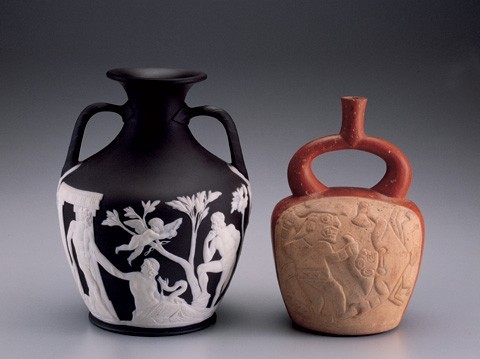
Portland vase and Peruvian stirrup vessel. Portland vase, marked “Wedgwood,” Staffordshire, 1820–40. Jasperware. H. 9 7/8". Stirrup vessel, Moche culture, Peru. H. 8 7/8". Earthenware. (Private collection; photo, Gavin Ashworth.) Note the use of relief decoration to depict cultural myths.
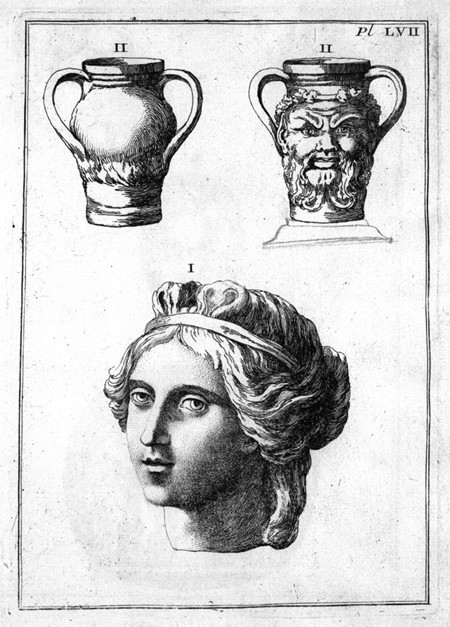
Head cantharus, plate 57, vol. 1. From Anne Claude Phillippe Caylus, comte de, Recueil d’Antiquitiés egyptiennes, etrusques, grecques et romaines, nouvelle edition (Paris: chez Desaint et Saillant, 1761). (Courtesy, Chipstone Foundation.) These books, originally owned by Josiah Wedgwood, contain a number of pencil annotations to the engravings. In this instance, note the addition of a base to the front-facing engraving.
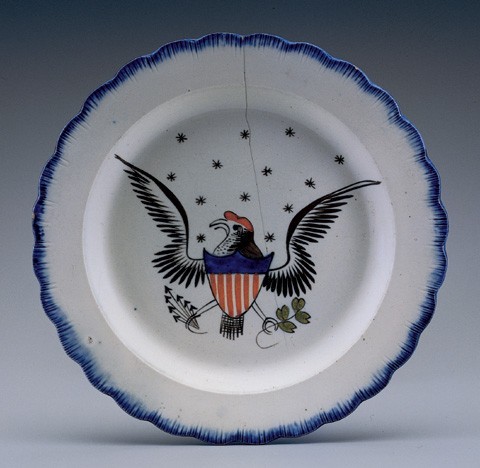
Plate, Staffordshire, ca. 1815. Pearlware. D. 8 3/8". (Private collection; photo, Gavin Ashworth.)
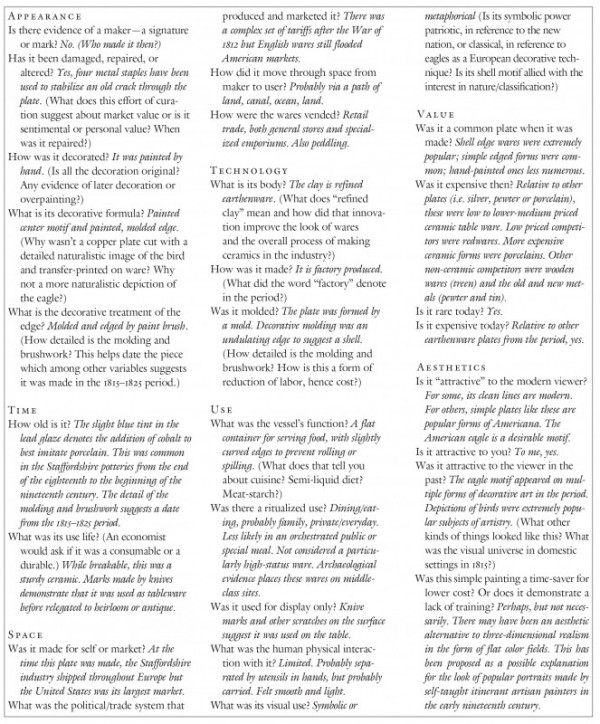
A study method for analyzing the plate with American eagle motif illustrated in fig. 7. By answering these questions, the analyst moves outward from an object to the societies that produced and used it. Later, comparisons and relationships with other objects or classes of artifacts are sought. Creative juxtapositions across time, space, and cultures raise new questions again structured in a matrix of time, space, technology, use, value, and aesthetics—and refine these answers.

Jug, Shelton, Staffordshire, 1803–1805. Creamware. H. 7 3/4". (Courtesy, Chipstone Foundation; photo, Gavin Ashworth.)
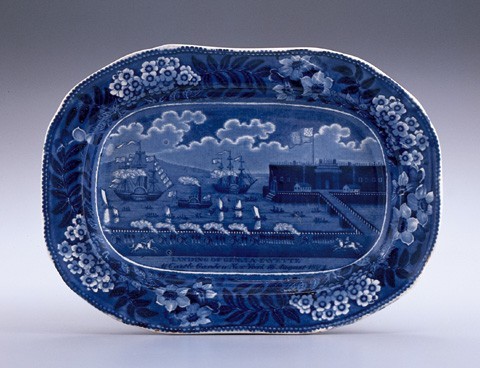
Dish, James and Ralph Clews, Staffordshire, ca. 1825. L. 9 1/2". (Courtesy, Chipstone Foundation; photo, Gavin Ashworth.) Landing of Lafayette.
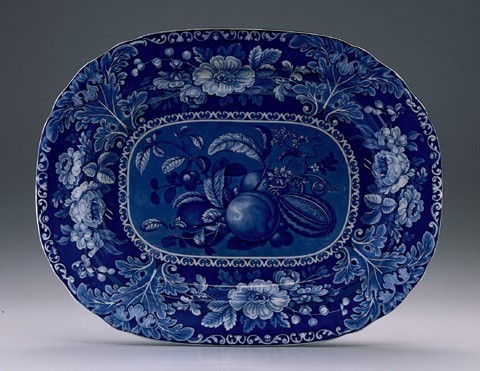
Dish, Joseph Stubbs, Burslem, Staffordshire, 1822–1835. White earthenware. L. 16 3/4". (Courtesy, Chipstone Foundation; photo, Gavin Ashworth.)

Detail of importer’s mark for Ludlow and Co. of Charleston, South Carolina, on the reverse of dish illustrated in fig. 11. (Courtesy, Chipstone Foundation; photo, Gavin Ashworth.)
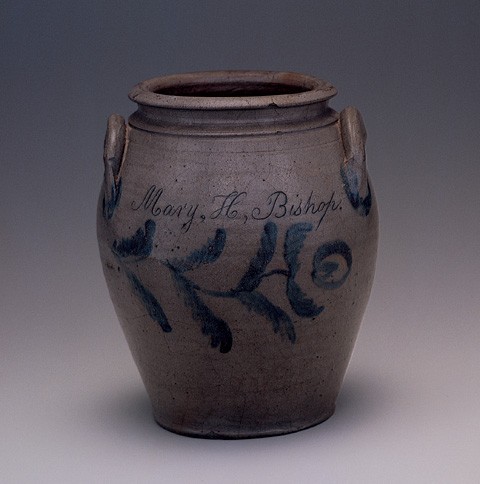
Jar, eastern Virginia, 1840–1860. Stoneware. H. 9 1/4 ". (Private collection; photo, Gavin Ashworth.) The cobalt decoration and the added incised inscription of “Mary Bishop” is atypical of the utilitarian nature of these common vessels made and used throughout America in the nineteenth century.

Dish, Ralph Simpson, probably Burslem, Staffordshire, 1680–1720. Slipware. D. 18 1/4". (Courtesy, Chipstone Foundation; photo, Gavin Ashworth.)
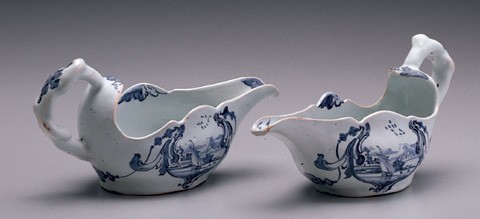
Pair of sauce boats, London, ca. 1760. Tin-glazed earthenware. L. 8 1/4". (Courtesy, Chipstone Foundation; photo, Gavin Ashworth.)
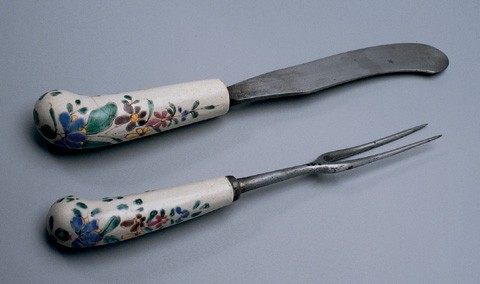
Knife and fork, Staffordshire, ca. 1760. Salt-glazed stoneware. Knife: L. 8 1/8". Fork: L. 7 1/4". (Courtesy, Chipstone Foundation; photo, Gavin Ashworth.)

Detail of shell-edge treatments of dishes illustrated in fig. 18. (Courtesy, Chipstone Foundation; photo, Gavin Ashworth.)
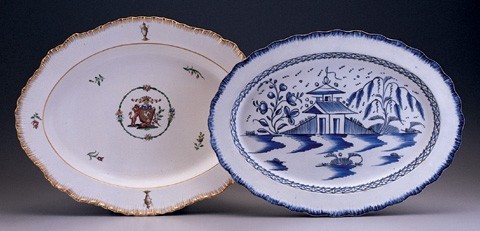
Dishes. Left: probably Liverpool, ca. 1800. Pearlware. L. 18 3/4". Right: Staffordshire or Liverpool, 1775–1810. Pearlware. L. 18 3/8". (Courtesy, Chipstone Foundation; photo, Gavin Ashworth.)
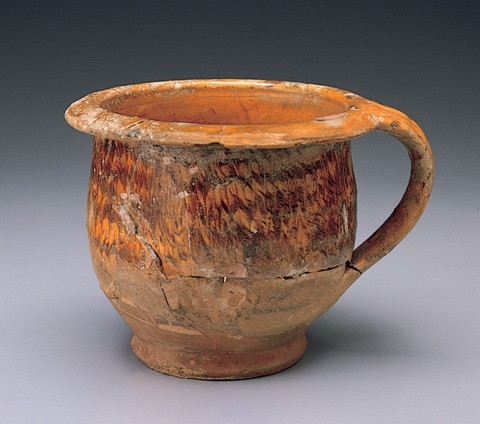
Chamber pot, Donyatt, North Devon, 1680–1700. Slipware. H. 6 3/4". (Courtesy, Chipstone Foundation; photo, Gavin Ashworth.)

Tureen, Staffordshire, ca. 1765. Creamware. H. 8 3/4". (Courtesy, Chipstone Foundation; photo, Gavin Ashworth.)
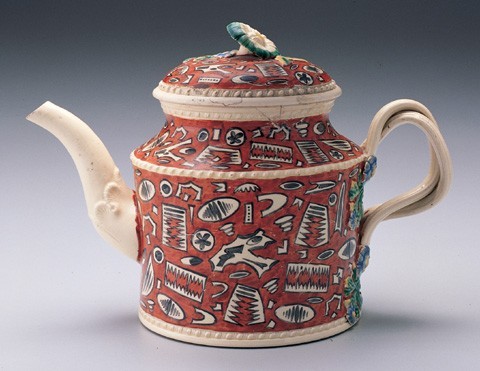
Teapot, probably Yorkshire or Staffordshire, ca. 1765. Creamware. H. 5 3/8". (Courtesy, Chipstone Foundation; photo, Gavin Ashworth.) Enameled in the so-called fossil pattern.

Sugar bowl and lid, Staffordshire or Sunderland, ca. 1820. Earthenware. H. 6". (Courtesy, Chipstone Foundation; photo, Gavin Ashworth.) Inscribed “EAST INDIA SUGAR NOT MADE BY SLAVES,” these antislavery slogans on ceramics were often commissioned for abolitionist societies.
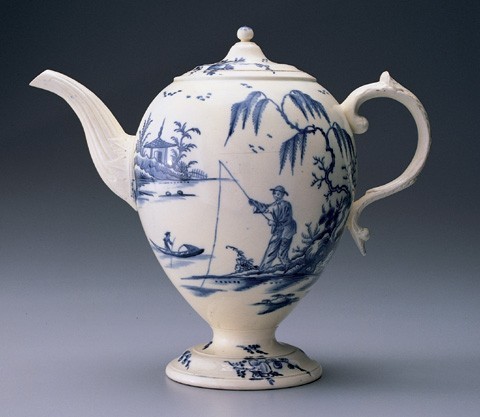
Coffee or chocolate pot, probably Yorkshire or Staffordshire, 1775–1790. Creamware. H. 8 7/8". (Courtesy, Chipstone Foundation; photo, Gavin Ashworth.)
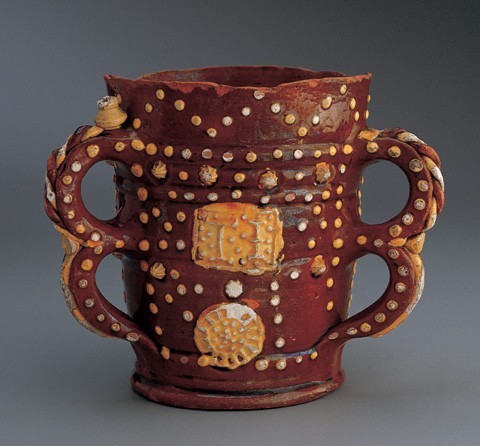
Tyg, Wrotham, Kent, 1649. Slipware. H. 5 7/8". (Courtesy, Chipstone Foundation; photo, Gavin Ashworth.) We might imagine the meeting of human and ceramic lips from the evidence of myriad chips on vessel rims. Multiple handles here also enabled passing the vessel from person to person, mouth to mouth.

Harvest jug, Barnstaple or Bideford, North Devon, 1748. Slipware. H. 12 1/8". (Courtesy, Chipstone Foundation; photo, Gavin Ashworth.)

Detail of the jug illustrated in fig. 22. “Now I am come for to Supply your workmen when in harvest dry when they do Labour hard and Sweat good drink is better fare then meat also in winter when tis cold I like wise then good drink can hold both Seasons do the Same require and most men do good drink desire John Hockin 1748.” (Courtesy, Chipstone Foundation; photo, Gavin Ashworth.)
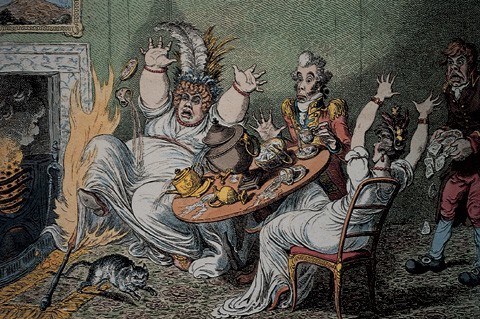
Hand-colored engraving, “The Advantages of Wearing Muslin Dresses!,” James Gilray. Published Feb. 15, 1802, by H. Humphrey, 27 St. James Street, London. (Private collection.)

Detail of the engraving illustrated in fig. 27.

Teapot, probably Derbyshire, ca. 1770. Creamware. H. 6". (Courtesy, Chipstone Foundation; photo, Gavin Ashworth.) An unusual green-glazed creamware teapot with the added embellishment of cold-gilding and the inscription “M. Wolfe”.
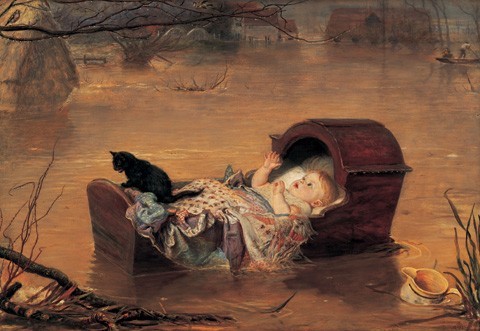
A Flood, Sir John Everett Millais, 1870. (Courtesy, Manchester City Art Galleries.)
